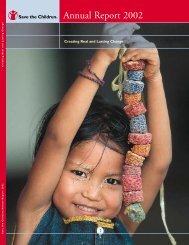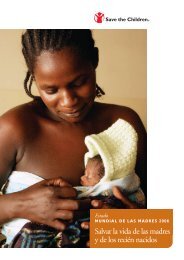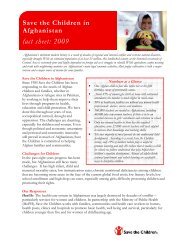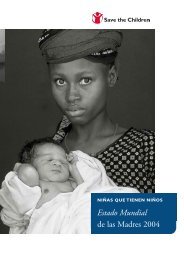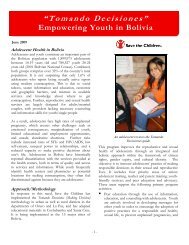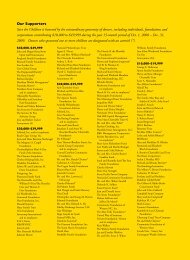The Power and Promise of Girls' Education - Save the Children
The Power and Promise of Girls' Education - Save the Children
The Power and Promise of Girls' Education - Save the Children
You also want an ePaper? Increase the reach of your titles
YUMPU automatically turns print PDFs into web optimized ePapers that Google loves.
<strong>The</strong> indicator that represents women’s<br />
political status is:<br />
Participation <strong>of</strong> women in national government<br />
When women have a voice in public institutions, <strong>the</strong>y<br />
can participate directly in governance processes <strong>and</strong><br />
advocate for issues <strong>of</strong> particular importance to women<br />
<strong>and</strong> children. This indicator represents <strong>the</strong> percentage <strong>of</strong><br />
seats in national legislatures or parliaments occupied by<br />
women. In bicameral legislatures <strong>and</strong> parliaments, a<br />
weighted average <strong>of</strong> <strong>the</strong> upper <strong>and</strong> lower house seats<br />
occupied by women is used.<br />
Source: Inter-Parliamentary Union 2004.Women in National<br />
Parliaments – Situation as <strong>of</strong> 30 November 2004.<br />
Available online at: http://www.ipu.org/wmn-e/classif.htm<br />
deficiency <strong>of</strong> one or more essential nutrients,<br />
regardless <strong>of</strong> <strong>the</strong> cause <strong>of</strong> such deficiency. Data are<br />
from 1989-2000.<br />
Source:<strong>The</strong> Man<strong>of</strong>f Group <strong>and</strong> <strong>the</strong> Micronutrient Initiative:<br />
Iron Improves Life (wall map). Available online at:<br />
http://www.man<strong>of</strong>fgroup.com/images/anemiamap.pdf<br />
<strong>The</strong> indicator that represents women’s<br />
educational status is:<br />
Adult female literacy rate<br />
Educated women are more likely to be able to earn a<br />
livelihood <strong>and</strong> support <strong>the</strong>ir families. <strong>The</strong>y are also more<br />
likely than uneducated women to ensure that <strong>the</strong>ir<br />
children attend school. Female literacy rate is <strong>the</strong><br />
percentage <strong>of</strong> women aged 15 <strong>and</strong> over who can read<br />
<strong>and</strong> write. Data are from 2002.<br />
Source:Table 24, pp. 217-220, from Human Development<br />
Report 2004: Identity, Diversity <strong>and</strong> Globalization by United<br />
Nations Development Programme, copyright 2004 by <strong>the</strong><br />
United Nations Development Programme. Used by<br />
permission <strong>of</strong> Oxford University Press, Inc. Available online at:<br />
http://hdr.undp.org/reports/global/2004/pdf/hdr04_HDI.pdf<br />
<strong>The</strong> indicators that represent children’s<br />
well-being are:<br />
Infant mortality rate<br />
<strong>The</strong> infant mortality rate is likely to increase dramatically<br />
when mo<strong>the</strong>rs receive little or no prenatal care <strong>and</strong> give<br />
birth under difficult circumstances. Infant mortality rate<br />
is <strong>the</strong> probability <strong>of</strong> dying between birth <strong>and</strong> exactly one<br />
year <strong>of</strong> age, expressed per 1,000 live births. Data are<br />
from 2003.<br />
Source: UNICEF 2004.<strong>The</strong> State <strong>of</strong> <strong>the</strong> World’s <strong>Children</strong><br />
2005 (Table 1). Available online at:<br />
http://www.unicef.org/sowc05/english/sowc05_Tables.pdf<br />
Gross primary enrollment ratio<br />
<strong>The</strong> gross primary enrollment ratio is <strong>the</strong> total number<br />
<strong>of</strong> children enrolled in primary school, regardless <strong>of</strong> age,<br />
expressed as a percentage <strong>of</strong> <strong>the</strong> total number <strong>of</strong><br />
children <strong>of</strong> primary school age. Data are from <strong>the</strong><br />
1998/1999 to 2002/2003 school years.<br />
Source: UNESCO Institute for Statistics, 2004. Gross <strong>and</strong> Net<br />
Enrolment Ratios for School Years 1998/1999, 1999/2000,<br />
2000/2001, <strong>and</strong> 2001/2002. Available online at:<br />
http://www.uis.unesco.org/TEMPLATE/html/Exceltables/<br />
education/gerner_primary.xls<br />
42<br />
THE POWER AND PROMISE OF GIRLS’ EDUCATION




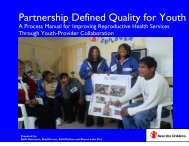

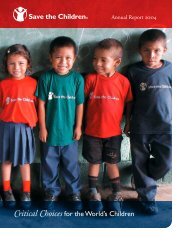
![View full document [PDF 3.39 MB] - PreventionWeb](https://img.yumpu.com/27308954/1/190x245/view-full-document-pdf-339-mb-preventionweb.jpg?quality=85)
